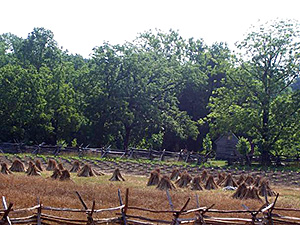Page content
Historic Farming
Wheat
Wheat, the traditional English bread grain, was grown in Virginia from the earliest settlement. However, it was not of great commercial concern until the middle of the 18th century when conditions for its profitability changed. Then, a growing demand made large scale production commercially profitable. Repeal of the Corn Act (restricting imports into Great Britain) in 1760 further stimulated the Virginia wheat market. Large Virginia tobacco planters were well-positioned to take advantage of this emerging market. Wheat would become Virginia’s second cash crop, and eventually supersede it in many areas of the Tidewater region through the last quarter of the 18th century.
Wheat was produced employing ancient European methods and technology. Surface growth in the field was turned under using a plow with horses or oxen. The soil was further broken down with a comb-like implement called a “harrow”. When a relatively smooth, fine-textured new soil surface was achieved, the seed was sown by walking through the field while throwing (or “broadcasting”) handfuls of seed in an even manner, so that the individual seeds were well-spaced. The sown bed was covered lightly with a second harrowing. As the majority of Virginia wheat was of the winter variety, sowing occurred in the late summer or early fall. A common practice was to sow wheat between rows of corn hills.
The seed soon germinated, producing a short green carpet before going dormant for the winter. It resumed its growth the following spring, and matured in early summer. By mid-June it was ripe, dry. and ready to harvest. Unlike tobacco, most of the wheat was mature at the same time, requiring the muster of many harvesters for the two-week period of intense labor. All labor participated in the wheat harvest, including house and trades people.
Wheat was harvested by cutting the straw near the ground with a hooked hand “sickle” or “reaphook;” or mown with a “cradle scythe.” Cut wheat was gathered in bundles and tied into “sheaves”. Sheaves were then stacked upright into small stands called “shocks.” These temporary stacks were soon transferred out of the field to larger outdoor stacks, or housed if possible, to await threshing. Threshing, or the physical separation of components, could occur through the fall and winter months.
Threshing was conducted via two, equally ancient methods. The first used a “flail” (or stick tied to another stick) to beat the wheat heads, thereby separating the wheat berries from their “chaff” (or husk) and supporting straw. The second method called “treading” achieved the same separation by using horses running over the sheaves laid on a circular floor. Larger quantities of wheat could be threshed easier by treading compared to flailing which might yield only five bushels of clean wheat per day per thresher.
Cleaning the wheat commenced with removal of the long straw. The remaining wheat, chaff and dust mix was run through a sieve (or “riddle”) on a breezy day, tossed into the air from a holding tray or basket so the wind could blow the lighter chaff and dust away, or fed into a “fanning” or “Dutch” mill to accomplish the same cleaning through mechanical means. Cleaned wheat was stored in a granary, taken to a local mill in 200-pound bags, or put in five-bushel barrels for export.
Since wheat generally held twice the market value of corn, it made an excellent cash crop. Large planters often participated in the lucrative flour trade, grinding their own and their neighbors’ wheat in water-driven mills located on their property. Most of the wheat and flour went to destinations that included Southern Europe and the Wine Islands and other North American colonies.
Virginia exported more than 170,000 bushels of wheat in 1772.

